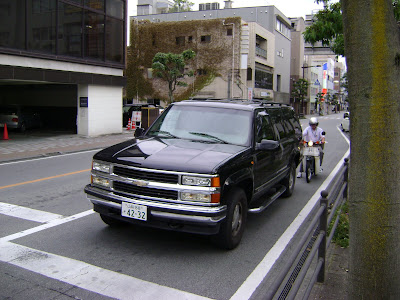
I've wanted to stay at a Japanese Capsule Hotel ever since I read about them in Nickelodeon Magazine when I was ten. The concept struck me as starkly representative of the super-efficient Japanese use of limited space, and I had an impression that capsule hotels were one of the hallmarks of Japanese culture.
I stayed at the Asakusa Riverside Hotel in Tokyo, next to a grimy outdoor seafood restaurant and across from a square where several hobos had camped out in cardboard boxes for the night. An emaciated gentleman behind the counter was annoyed by my attempt to speak Japanese, and instead directed me to a decrepit ticket vending machine using a series of coarse English phrases burned into his memory through years of repetition: fifth floor, turn right and right again, use locker room, shower room top floor, last shower nine AM, checkout 10 AM.
For 3,000 yen I received a locker for my bag, access to a shared bathroom, and sleeping capsule #506. The top floor housed the aforementioned shower room, a sauna, a coin washer and dryer, a narrow vending machine with coffee, soda, and four kinds of beer, two pachinko machines (undoubtedly the newest items in the entire establishment) a balcony overlooking the river and the Asahi building. The walls stood dull with the odor of mildew, and the walls—once a spotless white—had now dulled to an unsightly yellow. The whole place was very 1960's; and I half expected to see shag carpeting in the upstairs lounge, but instead found only a middle-aged businessman smoking cigarettes in his yukatta and scribbling in a notebook.

The actual capsule itself was actually bigger than I imagined, since I'd always heard the word "coffin" tossed around as a comparison. It was long enough for me to sleep comfortably, and tall enough to sit cross-legged. The capsule walls were as discolored as the rest of the place, and the interior was designed with a very Logan's Run view of how people forty years ago must have imagined the future. My control panel (center of the photo) had light switches, air control, a faded digital alarm clock, AM/FM radio, and the channel listings for the coin-operated television (top left). The futon was thinner than what I'm used to, but not so thin as to disturb my sleep. A window shade (also very '60s, this time with wood paneling!) provided privacy from the rest of the hallway, where only six of the twenty capsules were occupied. Everyone on my floor (on purpose, no doubt) was a gaijin.
As far as I can tell, capsule hotels are an outdated staple of Japanese ingenuity comparable to laserdisc players or fondue sets in the west. Every Japanese person I described the experience to told me I was crazy to go. Gaijin looking for cheap Tokyo lodging and older men who recall the capsule hotel's heyday make up the bulk of the clientele, along with those younger salarymen who miss last train and need a place to sleep off the night's nama-biru and tsumami.
All I have left to say is that Nickelodeon Magazine, you've done it again.
